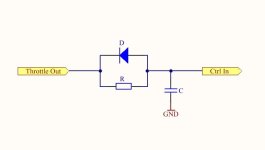appleseed123
1 W
I was wondering how I could change my bike to be easier on take offs. Since the controller (lyen) works by trying to limit speed and not torque, I have applied abit more torque than I wanted at take offs. Obviously this is not good for the bike since going from stationary to moving is most likely the highest current drain (torque producing) moment in riding.
So I was thinking maybe I could delay the voltage going to the controller with a capacitor, instead of just relying on my hand to limit it at take offs? Would it work?
If it does, the bigger the capicator, the more the delay of torque and thus a nicer take off without hurting torque too much when getting up to speed. Is that right?
If anyone has a better idea to prevent sudden unintended bursts of torque (maybe programming?) please tell me.
So I was thinking maybe I could delay the voltage going to the controller with a capacitor, instead of just relying on my hand to limit it at take offs? Would it work?
If it does, the bigger the capicator, the more the delay of torque and thus a nicer take off without hurting torque too much when getting up to speed. Is that right?
If anyone has a better idea to prevent sudden unintended bursts of torque (maybe programming?) please tell me.


